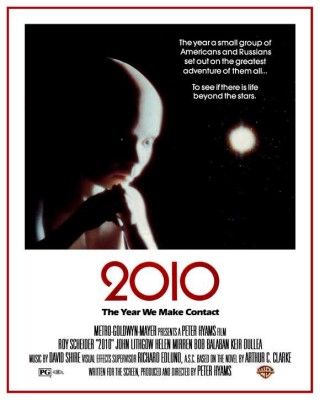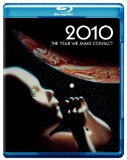| Reviews & Columns |
|
Reviews DVD TV on DVD Blu-ray 4K UHD International DVDs In Theaters Reviews by Studio Video Games Features Collector Series DVDs Easter Egg Database Interviews DVD Talk Radio Feature Articles Columns Anime Talk DVD Savant Horror DVDs The M.O.D. Squad Art House HD Talk Silent DVD
|
DVD Talk Forum |
|
|
| Resources |
|
DVD Price Search Customer Service #'s RCE Info Links |
|
Columns
|
|
|
2010
Director Peter Hyams's 2010 (1984) is about one-fifteenth the movie that Stanley Kubrick's 2001: A Space Odyssey (1968) is, but don't consider that a total condemnation. Without Kubrick's participation, 2010 was pretty much doomed from the start, despite the input of novelist Arthur C. Clarke and a certain fidelity to some aspects of the original production. It's an odd picture, with isolated components beautifully realized, while in other ways the innovations of the first film are forsaken, replaced with very conventional sci-fi iconography and a too-literal approach.
Still, while it never comes within a light-year of the greatness of 2001, 2010 is sincerely made with enough interesting things going on to make it a worthwhile viewing experience even if, ironically, today it's much more dated than 2001 ever will be. Warner Home Video's Blu-ray disc is okay but a no-frills affair with minimal extras. That's too bad because sometimes exploring a disappointing film can be more interesting than simply heaping praise on a great one. I'd have enjoyed hearing what the filmmakers think of the film now, in retrospect. On the other hand, the 1998 DVD was 4:3 letterboxed and not 16:9 enhanced, so this high-def release is a major upgrade.
Some time after the events in 2001: A Space Odyssey, Dr. Heywood Floyd (played in the original by William Sylvester, replaced here by bigger-draw Roy Scheider) has left the National Council on Astronautics but is nonetheless approached by a Russian scientist (Dana Elcar) with an intriguing offer: since both the Soviet Union and the United States want to unravel the mystery of the alien monoliths and the fate of the Discovery and its HAL 9000 computer, why not cull their best resources? The Soviet ship will make it to Jupiter one year ahead of the Americans, while the Americans can more efficiently access the data aboard the Discovery and determine what went wrong with its seemingly paranoid computer, HAL 9000.
A joint-mission is launched, this despite the fact that the Cold War between the United States and the Soviet Union is heating up, over a vaguely-defined conflict involving a military blockade in Honduras. Joining Commander Kirbuk (Helen Mirren) and her crew are Floyd, Discovery designer Walter Curnow (John Lithgow), and the eccentric creator of HAL, Dr. Chandra (Bob Balaban). Their approach to Jupiter seems to trigger a strange series of events, including the heretofore unknown existence of life-supporting elements on Europa, one of Jupiter's moons, and ghostly apparitions of astronaut Dave Bowman (Keir Dullea) on both the long-abandoned Discovery and back on Earth.
When it was new, few thought 2010 was going to surpass or even match the original's impact, but there was also a lot of anticipation about how it might resolve the original film's many mysteries, and how it would depict mankind's first encounter with alien life forms. (The subtitle "The Year We Make Contact" was in the ads only; onscreen the title is simply 2010.) Watching the film again, I was reminded how, in 1984, an early scene involving an unmanned probe flying low over the surface of Europa generated palpable excitement in the theater audience; everyone thought they might finally get a glimpse at the aliens behind those mysterious black slabs.
Instead, the picture's Spielbergian feel-good ending satisfied almost no one.* It was both too-literal and a cop-out at once. It's so badly botched that instead of something like an extension or an epilogue to 2001, this part of the film almost plays like the spiritual goofiness of Red Planet Mars (1952), an anticommunist Cold War sci-fi religious thriller. Significantly, the Cold War tensions in 2010, of astronauts isolated from a world on the brink of World War III, is similarly derivative; among other things, it's a lot like "Probe 7, Over and Out," a Rod Serling-penned episode of Twilight Zone. Significantly, the Cold War tensions were not in Clarke's novel at all; in the book the Cold War had already ended. Although actress Helen Mirren and Latvian actor Elya Baskin are very good in their roles (at the time I assumed Mirren was a native-born Russian**), Hyams's script - he was also the film's producer and director of photography, as well as its director and screenwriter - does their characters no favors; the Americans have all the right answers while the Russians tend to be pig-headed and foolhardy throughout.
Even before its unfortunate ending, 2010 had already lost a big chunk of its audience with its tendency toward conventional narrative devices. The worse of these is Roy Scheider's incessant narration. In the form of log entry-type letters to his family, Floyd tells them things the audience already knows, or emotions better left unsaid or expressed visually. "Dear Caroline," begins one such passage, complete with echo-chamber audio, "This is it...We are finally going to be face-to-face with the monolith!"
The film frustratingly wants to have it both ways: classical excerpts, namely Strauss's Also sprach Zarathustra and Ligeti's Lux Aeterna are reused from Kubrick's film, but most of the film features a terrible new score by David Shire with cues that give the film the air of a cheap thriller. On one hand, sets of the Discovery's interior have been meticulously recreated but the design of the Soviet craft, both exterior effects shots and interior sets, is much closer to something like Alien than 2001. Where Kubrick's obsession with scientific accuracy distinguished 2001 from almost all previous science fiction films, such as the explicit absence of sound effects in all the outer space scenes, in 2010 spacecraft roar through airless space like the TIE fighters in Star Wars.
And yet despite all these complaints, other aspects of 2010 are very good. Particularly well done are the too few scenes involving Balaban's character, who regards advanced computers as sentient beings deserving of the same respect and consideration as living creatures. There's a wonderful scene early in the film between Dr. Chandra and SAL 9000 (voiced by Candice Bergen, amusingly credited as "Olga Mallsnerd") that almost poetically regards mortality, souls, dreams, etc. It's a beautifully-written sequence and Balaban, an underrated performer, is excellent. Later on, there's more of the same good material between Chandra and the reactivated HAL (again voiced by Douglas Rain). Unfortunately the film doesn't exploit this gold mine of promising reunion, instead choosing to play on HAL's notoriety for some cheap suspense near the end of the picture.
On one hand it's great to see Keir Dullea who, thanks to Michael Westmore's makeup, is almost creepily unchanged in the 16-plus years since the original film's production. His ghostly visitations with Dr. Floyd, like the scenes with HAL, are full of potential but barely scratch the surface, and not necessarily in the right ways.
But there are other isolated good scenes and ideas: Lithgow's space walk is exciting, as is his sequence with Baskin exploring the long-unoccupied Discovery, which is thrilling and atmospheric. (In a neat touch, the surface of the craft has become dusted with yellow sulfur.) Early scenes in the film set on Earth are very restrained, presenting a future daily existence not much different from that in 1984, which turned out to be a more accurate prediction than the many wonders predicted in 2001, though it's also less exciting visually, and unimaginative. The picture also boasts uniformly fine acting and the special effects are good in the way they present views of space from unusual angles with interesting lighting.
Video & Audio
Disappointingly, 2010 was shot in conventional 35mm Panavision and not in 65mm like 2001, although there were a few 70mm blow-up engagements with six-track magnetic stereo prints. The Blu-ray is a huge upgrade from the 4:3 LBX DVD release, but only moderately impressive compared with other 'scope Blu-ray titles from the same general era. The MGM logo on this is about as bad-looking as this reviewer has ever seen, but the feature looks good for the most part. On a big theater screen the visual effects were impressive in their scope and the Blu-ray recaptures some of this feeling for the first time since the film's release. It's also particularly good at accurately capturing the blackness of space and the interiors of the Soviet craft, which tend toward a lot of red-themed lighting, which earlier home video versions had trouble reading.
Originally released in standard Dolby Stereo (plus those six-track mag prints), 2010 is presented here in a Dolby TrueHD 5.1 mix that improves things slightly but not dramatically. The many alternate languages options include 5.1 Dolby Digital mixes in English, French, German, and Castilian Spanish; 2.0 tracks in Latin Spanish and Italian, and a 1.0 mono track in Portuguese, with optional subtitles in English, French, Spanish, Dutch, Finnish, German, Italian, Norwegian, Portuguese, and Swedish. Though not listed the disc is also encoded with Japanese subtitles, triggered on Japanese players.
Extra Features
The only supplements are a 9:20 featurette, 2010: The Odyssey Continues, which is 4:3 full frame and may have been produced for exhibitors rather than general audiences. Though too short it does feature interviews with most of the key participants with behind-the-scenes footage of the first and special effects units. A theatrical trailer, in 4:3 LBX format looks so awful that it's almost like a joke; it's odd that Warner Bros. seems reluctant to remaster trailers for their high-def releases.
Parting Thoughts
Though resolutely economy class compared to its predecessor, 2010 is an interesting work jumbling a lot of bad ideas and decisions with a handful of really good ones. To say the film could have been much, much worse is damning it with faint praise, but what works in 2010 counteracts much of what doesn't - just enough to rate this Recommended.
* Another Spielbergian touch was the strange idea of having Floyd sharing his home with a pair of dolphins. (And literally Spielbergian it is: Scheider's character on Spielberg's SeaQuest DSV kept a dolphin, too.) Wouldn't having to feed them big buckets of mackerel three times a day run into money?
** Sergei Hasenecz adds, "She is by descent. She was born Ilyena Vasilievna Mironov. Her father was Russian-born. Her grandfather - a nobleman, tsarist colonel and diplomat - was in England with his family when the Revolution erupted. While her mother was English, Helen Mirren grew up speaking Russian and English. Her Russian military heritage goes at least as far back as her many-times-great-grandfather, a hero during the Napoleonic Wars. Interestingly, in light of her Academy Award for portraying Elizabeth II (and keeping in mind the other royalty she has played), Mirren describes her upbringing as 'very anti-monarchist.' I'm surprised that this is the first time you'd noticed Helen Mirren. The first time I saw her was in Caligula -not the most auspicious introduction. But she impressed me even there. Of course, her nudity helped."
Film historian Stuart Galbraith IV's latest book, Japanese Cinema, is due in stores this June, and on sale now.
|
| Popular Reviews |
| Sponsored Links |
|
|
| Sponsored Links |
|
|
| Release List | Reviews | Shop | Newsletter | Forum | DVD Giveaways | Blu-Ray | Advertise |
|
Copyright 2024 DVDTalk.com All Rights Reserved. Legal Info, Privacy Policy, Terms of Use,
Manage Preferences,
Your Privacy Choices | |||||||















